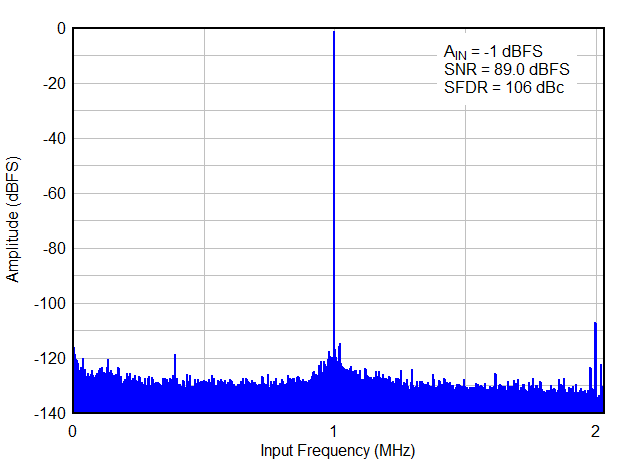SBASA01B September 2020 – March 2022 ADC3660
PRODUCTION DATA
- 1 Features
- 2 Applications
- 3 Description
- 4 Revision History
- 5 Pin Configuration and Functions
-
6 Specifications
- 6.1 Absolute Maximum Ratings
- 6.2 ESD Ratings
- 6.3 Recommended Operating Conditions
- 6.4 Thermal Information
- 6.5 Electrical Characteristics - Power Consumption
- 6.6 Electrical Characteristics - DC Specifications
- 6.7 Electrical Characteristics - AC Specifications
- 6.8 Timing Requirements
- 6.9 Typical Characteristics
- 7 Parameter Measurement Information
- 8 Detailed Description
- 9 Application and Implementation
- 10Power Supply Recommendations
- 11Layout
- 12Device and Documentation Support
- 13Mechanical, Packaging, and Orderable Information
Package Options
Mechanical Data (Package|Pins)
- RSB|40
Thermal pad, mechanical data (Package|Pins)
- RSB|40
Orderable Information
3 Description
The ADC3660 device is a low-noise, ultra-low power, 16-bit, 65-MSPS dual-channel, high-speed analog-to-digital converter (ADCs). Designed for low power consumption, the device delivers a noise spectral density of –159 dBFS/Hz, combined with excellent linearity and dynamic range. The ADC3660 offers excellent dc precision, together with IF sampling support, which make the device an excellent choice for a wide range of applications. The ADC consumes only 71 mW/ch at 65 MSPS, and power consumption scales very well with lower sampling rates. In bypass mode (up to 31 MSPS) the output data is available after 1 or 2 clock cycles.
The ADC3660 uses a serial CMOS (SCMOS) interface to output the data which minimizes the number of digital interconnects. The device supports a two-lane, a one-lane and a half lane option. The serialized CMOS interface supports output rates to 250 Mbps which translates to ~ 15 MSPS (2-wire) to ~ 3.75 MSPS (0.5-wire) output rates after complex decimation. Hence the ADC3660 can be operated in 'oversampling + decimating' mode using the internal decimation filter in order to improve the dynamic range and relax external anti-aliasing filter.
The device comes in a 40-pin WQFN package (5 mm × 5 mm) and supports the extended industrial temperature range of –40 to +105⁰C.
| PART NUMBER (1) | PACKAGE | BODY SIZE (NOM) |
|---|---|---|
| ADC3660 | WQFN (40) | 5.00 × 5.00 mm |
 FS = 65 MSPS, Fin = 1 MHz, 16x Decimation, real
FS = 65 MSPS, Fin = 1 MHz, 16x Decimation, real